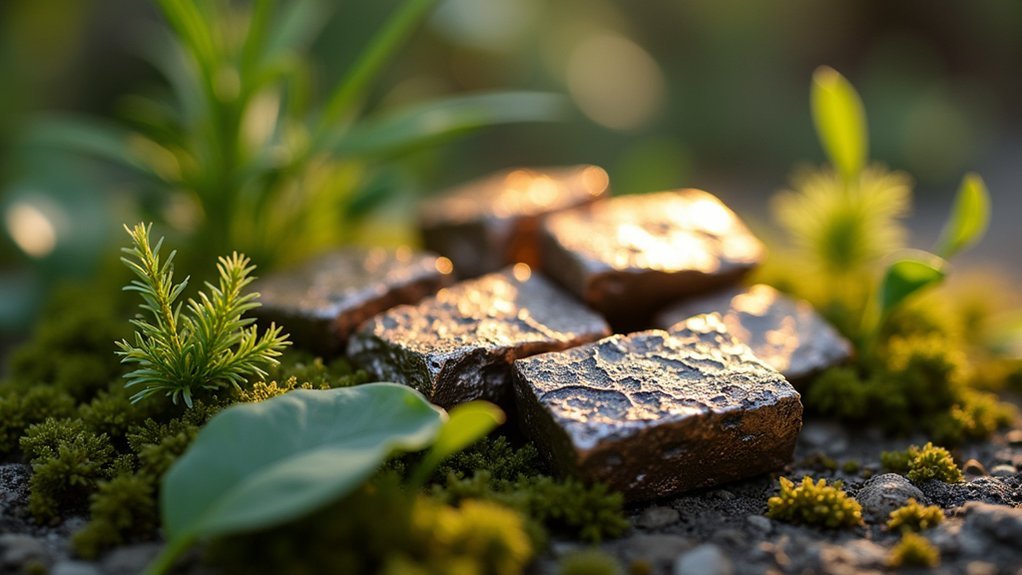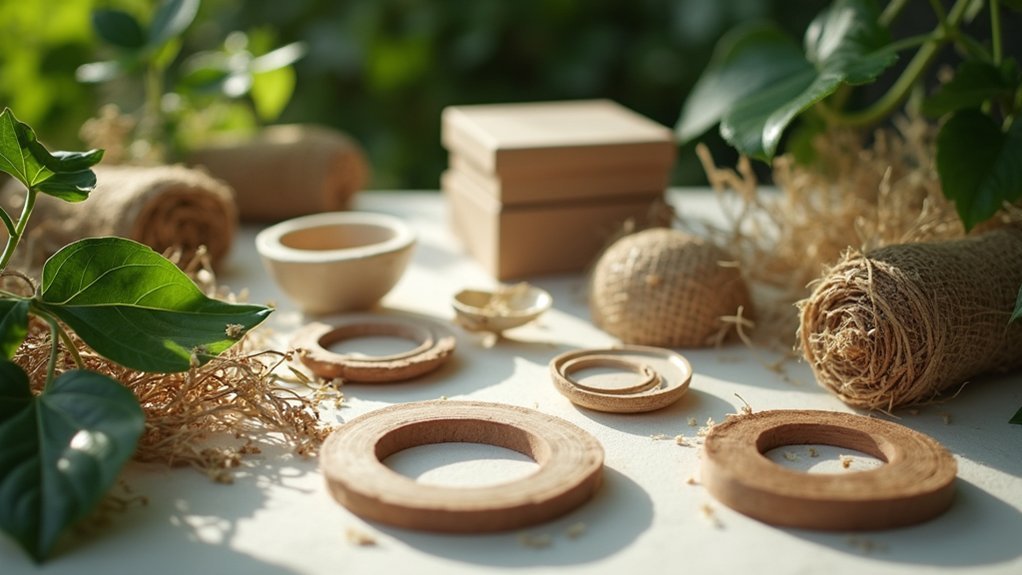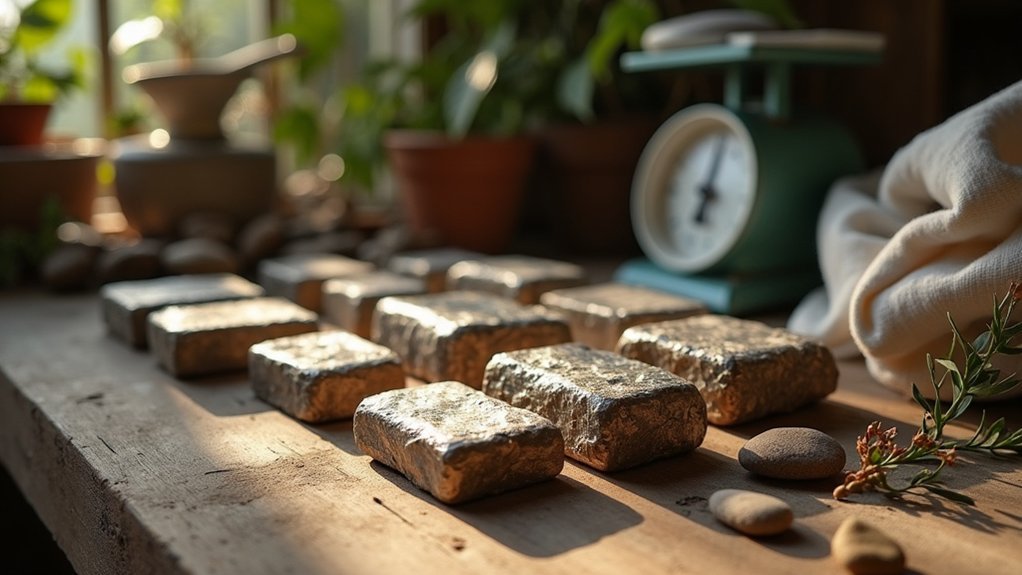You can make your jewelry casting more eco-friendly by choosing recycled metals instead of newly mined materials, which eliminates the massive environmental impact of extracting precious metals from the earth. Set up a home-based studio to reduce commuting emissions, implement scrap metal recovery systems to reuse all waste materials, select lab-created gemstones that use 90% less energy than mining, and adopt sustainable packaging made from recyclable materials. These foundational practices will transform your casting process into an environmentally responsible operation.
Choose Recycled Metals for Your Casting Materials

One of the most impactful changes you can make in eco-friendly jewelry casting is switching to recycled metals like silver and gold.
These sustainable materials drastically reduce environmental impact—mining one gold ring requires digging 20 tons of earth and emits 57 kg of CO2. You’ll find recycled silver readily available from suppliers who transform waste like old x-ray plates into valuable casting materials.
By choosing responsible sourcing through Fairmined and Fairtrade certified options, you’re supporting fair labor practices and ethical jewelry standards. This approach contributes to a circular economy, eliminating new mining operations while preserving natural resources.
Your eco-friendly jewelry casting decisions help create a more sustainable industry for future generations.
Set Up a Home-Based Casting Studio to Reduce Carbon Footprint
When you establish a casting studio in your home, you’ll eliminate daily commutes and dramatically cut the greenhouse gas emissions tied to transportation.
Your home studio becomes a cornerstone of sustainable jewelry making, reducing your overall carbon footprint while maintaining professional results.
A home casting studio empowers jewelry makers to create beautiful pieces while championing environmental responsibility and sustainable craftsmanship practices.
Transform your workspace with these eco-conscious upgrades:
- Install solar panels to power your soldering station with renewable energy
- Stock eco-friendly casting supplies and recycled metals exclusively
- Create dedicated containers for collecting scrap silver and metal remnants
- Design efficient workflow zones to minimize energy consumption
You’ll gain better control over your environmental impact through improved waste management practices.
Jewelry makers who operate from home studios can easily implement recycling protocols and monitor their resource usage, making every casting session more environmentally responsible.
Implement Scrap Metal Recovery and Reuse Systems

Since precious metals represent your most valuable raw materials, implementing an all-encompassing scrap recovery system will maximize your material efficiency and minimize waste in every casting project.
Start by establishing dedicated scrap bins to collect metal waste during your jewelry-making process, categorizing materials by type for efficient reuse systems.
You’ll want to regularly sweep workspaces to recover precious metal dust and particles that accumulate during production.
Weigh and document all collected scrap to track quantities available for melting and repurposing into new pieces.
Partner with local refining services to transform waste into valuable raw materials for sustainable jewelry-making.
Train yourself and any assistants on proper scrap metal recovery techniques.
This eco-friendly approach addresses environmental concerns while creating a more profitable, recycling-focused jewelry studio operation.
Select Lab-Created Gemstones for Stone-in-Place Casting
Lab-created gemstones offer an environmentally responsible alternative to mined stones while maintaining the beauty and durability you need for stone-in-place casting projects.
These sustainable materials use 90% less energy than mining natural diamonds, dramatically reducing your carbon footprint while providing affordable alternatives that cost 20-40% less than mined counterparts.
Lab-created gemstones deliver 90% energy savings and cost 20-40% less than mined alternatives while dramatically reducing environmental impact.
When selecting lab-created gemstones for eco-friendly casting, you’ll benefit from:
- Minimal environmental impact through controlled manufacturing processes
- High-quality stones with consistent clarity and fewer inclusions
- Reduced resource consumption requiring less water and energy
- Ethical sourcing without land disruption or mining-related environmental damage
Adopt Sustainable Packaging Practices for Finished Pieces

After creating beautiful eco-friendly jewelry pieces, you’ll want to guarantee your packaging choices align with your environmental values.
Choose kraft jewelry boxes made from recyclable cardboard that customers can easily dispose of in recycling bins, minimizing environmental impact. Incorporate cotton anti-tarnish inserts crafted from biodegradable materials to protect your silver jewelry while reducing synthetic alternatives.
You can reduce waste throughout your supply chain by reusing delivery packaging from suppliers for mailing finished pieces. For cushioning, opt for eco-friendly biodegradable packing peanuts or recycled paper that’s completely compostable.
Always clearly label your sustainable packaging as recyclable to encourage responsible disposal and promote environmental consciousness among customers purchasing your jewelry.
Frequently Asked Questions
How to Make Environmentally Friendly Jewelry?
You’ll create environmentally friendly jewelry by using recycled metals, lab-created gemstones, and low-waste casting techniques. Implement scrap recovery systems, power operations with renewable energy, and choose biodegradable packaging for shipping.
Can Jewelry Be Eco-Friendly?
You can absolutely make jewelry eco-friendly by choosing recycled metals, lab-created gemstones, and sustainable casting methods. You’ll reduce environmental impact while creating beautiful pieces that don’t compromise your values or quality.
How Is Sustainable Jewelry Made?
You’ll find sustainable jewelry’s made using recycled metals like gold and silver, ethically sourced gemstones, and lab-grown stones. Makers use small-batch production, low-waste casting methods, and upcycle existing materials to minimize environmental impact.
What Is the Most Sustainable Metal for Jewelry?
You’ll find recycled gold and silver are the most sustainable metals for jewelry. They eliminate mining’s environmental impact while maintaining quality and beauty. Fairmined-certified gold offers another excellent sustainable option you should consider.
In Summary
You’ve got the power to transform your jewelry casting practice into an environmentally responsible craft. By choosing recycled metals, setting up your home studio, recovering scrap materials, selecting lab-created stones, and using sustainable packaging, you’ll greatly reduce your environmental impact. These changes don’t just benefit the planet—they’ll often save you money and create unique selling points for your jewelry business. Start implementing these eco-friendly practices today.





Leave a Reply